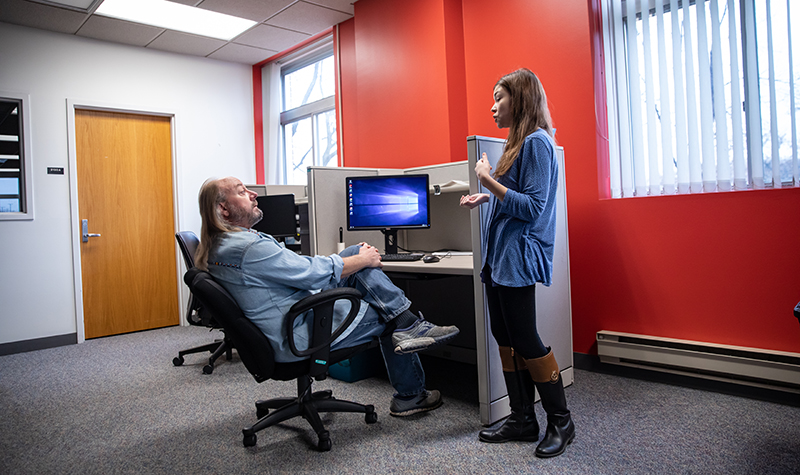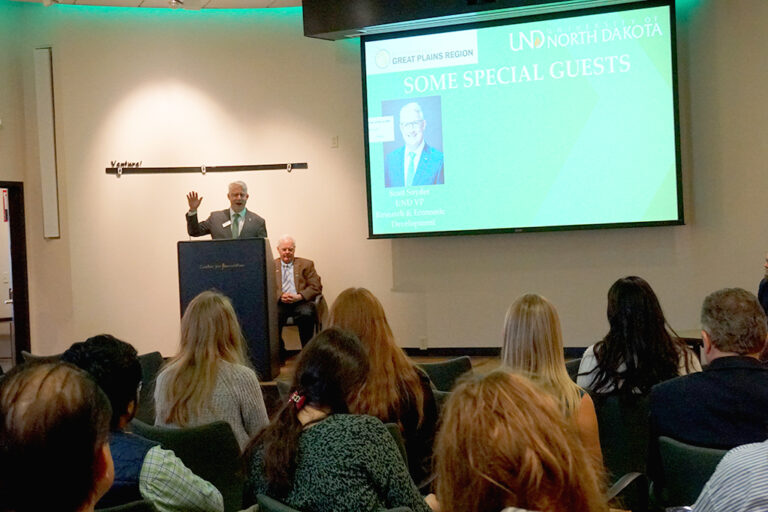Inside INPSYDE, UND’s Indians Into Psychology Doctoral Education program
UND has produced more Native American/First Nations Ph.D. clinical psychologists than any other APA-accredited program

Academically and communally, the Indians Into Psychology Doctoral Education program (INPSYDE) at the University of North Dakota works in constant high gear. But this year, the program’s heft in crucial administrative matters came to the fore, too.
In the fall, after filing away a mound of reports and documents, INPSYDE began a new five-year funding cycle, while celebrating the successful accreditation of UND’s overall Ph.D. program in clinical psychology under revised standards by the American Psychology Association (APA).
The program is one of the first under the new standards to have earned the APA’s stamp of educational approval for the next 10 years.
“We got an explicit shout out to INPSYDE Director Justin Douglas ‘Doug’ McDonald and his students from the site visit team from our accrediting body at the APA,” said Joseph Miller, director of clinical training.
An integral part of the Ph.D. program in clinical psychology, INPSYDE caters to Native doctoral students academically, financially and culturally. It also provides cross-cultural awareness to all students with the aim of increasing the otherwise meager ranks of psychologists who competently tend to the mental health needs of Native Americans.
Receiving funds and obtaining accreditation may be regular issues to deal with at a university, but their significance for INPSYDE and the clinical psychology program emerges when one considers the history and symbiosis of the two entities.
The start of INPSYDE
For example, a personality assessment question that asks whether a patient hears what others do not may cue to schizophrenia or thought disorders. Yet, such an inquiry does not account for the spiritual experiences of Native people.
“Hearing and seeing things that other people don’t is one of the most important and significant goals of a vision quest, or being in touch with your ancestors in the spirit world,” said McDonald, who, besides directing the INPSYDE program, is past regional president of the APA’s Division 45.
This is just one example of how psychology as a discipline has for decades failed to accommodate Native Americans, McDonald said. An enrolled member of Oglala Lakota Sioux tribe in South Dakota, McDonald saw that failure first-hand while growing up in the Northern Cheyenne Reservation in Montana.
Most of the time, there were no practicing clinical psychologists on the reservation at all. And on the rare occasions when there were, the clinicians often would lack the cultural competence to make a difference.
Still, McDonald had a psychologist to look up to at home: his father, who earned his credentials in experimental psychology. Arthur McDonald, who was among the first Native Americans to receive a doctoral degree in experimental psychology, had advocated for sensible Native mental health care and education.
“I had some idea of what a psychologist was or what a psychologist could be just from having my dad as a role model in that regard,” McDonald said.
To a degree, McDonald retraced his father’s path to the University of South Dakota, where the younger McDonald earned a Ph.D. in clinical psychology. Upon graduation in the early 1990s, McDonald joined the ranks of some 100 Native psychologists nationwide.
“In 1992, 100 [Native American psychologists] for 2 million Indians in this country,” said McDonald. “That’s ridiculously inadequate.”
McDonald had a vision to upend the “system” in order to make it work for Native people. He pushed for doctoral programs in psychology that would be focused on Native Americans and their cultures.
“I got it in my head to develop to an entirely new system then that could recruit and bring more Native people into the field to go out then and work with their people,” said McDonald. “A lot of it had to do with my own personal experience of just understanding the need.”
For his idea, he won over powerful allies, including then-Sens. Byron Dorgan of North Dakota and Daniel Inouye of Hawaii, plus Pat DeLeon, the former president of the APA who served as Inouye’s chief of staff.
In 1992, McDonald was a newcomer to UND and a founder of the national Indians Into Psychology curriculum that was written into the federal Indian Health Care Improvement Act. The law provided for three Indians Into Psychology programs across the country, one of which was to be permanently established at UND.
“With the many Indians-focused programs that were at UND, if I came here and established this program, I wouldn’t be reinventing any wheels,” said McDonald of his decision to root his career and INPSYDE program at UND. “This university was good at having Indian-related programs, more so than certainly any other university that I’ve been associated with.”
Over time, the other two Indians Into Psychology programs took hold at the University of Montana and Oklahoma State University.

Novelty of INSPYDE
At the dusk of the 20th century, Indians Into Psychology was not necessarily a groundbreaking initiative in its intent to serve Native students and populations. What was novel was the design to fully integrate the program into psychology departments.
“I realized that if you’re going to have a program like this, it has to be hardwired into departments,” said McDonald, who studied other Native-focused initiatives in order to shape up the Indians Into Psychology program. “It can’t be a supplement or a supplemental program.”
At UND, INPSYDE is such an entrenched part of the clinical psychology program – and is so important for recruitment, accreditation and national recognition – that Miller described it as “quite the feather in our cap.”
Of course, any such program requires steady funding. But in its initial years, there was hardly any money, federal or local, earmarked for INPSYDE.
At UND, in the Department of Psychology, INPSYDE was started – and ran for two years – without funds. Then, renewable financing for five-year spans arrived from the Department of the Interior through the Indian Health Service (IHS).
And while INPSYDE has continuously secured funding since then, that process has not been easy. For example, UND’s INSPYDE program typically gets $250,000 per annum every five years; but four years ago, it suffered a serious cut.
“I got a notice from IHS and I learned a new word – rescission,” said McDonald.
Rescission meant IHS slashing 20 percent of INSPYDE’s budget.
With a treacherous landscape in Washington marked by several recent shutdowns, funding remains a constant concern, more so than vital activities such as recruitment.
Recruiting the next generation of Native psychologists
Every year, the doctoral program in clinical psychology offers spots for two INPSYDE scholars. Sometimes, more students earn admission; sometimes, none do. It depends on the strength of candidates’ qualifications and their determinations to serve Native populations.
At any given time, nonetheless, about a quarter of UND Ph.D. students in clinical psychology come from INPSYDE, a tally that is among the highest – if not the very highest – in the nation. Moreover, “the graduation rate among American Indian scientist-practitioner clinical psychology Ph.D. students at UND approximates that of all other similar national training programs combined,” the program’s website states.
Since its inception, the program has graduated 30 Native psychologists.

“We talk about the impact on the students that we graduate,” said Miller. “But you think about the impact that those people have on the people they work with when they go back into their communities. It’s huge. It’s a real important thing.”
To achieve this track record, McDonald and INPSYDE students engage in extensive outreach campaigns around the country and with various tribes.
Often, McDonald’s interaction with and mentorship of students begin well before the students arrive at UND.
McDonald’s work also requires collaborating with tribes to set up university pathways for high schoolers (including through a summer institute) as well as internships and job placements for Ph.D. candidates. The placements serve not only those who are in the INPSYDE program but also those who are not.
“As successful as the three national INPSYDE programs are, we are never going to be able to graduate enough Indian psychologists,” said McDonald. “We have to generate more allies.”
That is why McDonald sees the INPSYDE program at UND as a support and service to both Native and non-Native students, with the latter acquiring the cultural awareness to serve indigenous peoples.
When embedding a non-Native student with a tribe, McDonald said, “we’re only going to send those who have proven their cross-cultural competence.” In other words, UND is going to send “the very best and brightest” to work with tribes.
In a discipline long plagued by its disregard for non-white experiences, having Ph.D. students of various backgrounds provide effective mental health care at tribal facilities highlights the success of UND’s INPSYDE program – and, of course, of McDonald’s position as a broker of opportunities and accomplishments.
“Doug does the diplomat and the ambassador role incredibly well,” said Miller. “He just walks the walk all the time. By doing those things that he does, by being who he is, he draws people into that world, into that level of comfort that they might otherwise be a little timid about in terms of crossing a threshold.
“He comes across the threshold and pulls you back in,” Miller continued. “And that’s a rare gift.”


